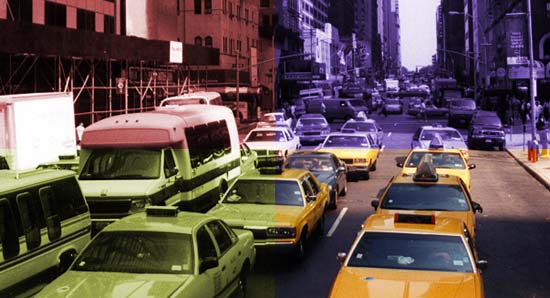|

The Car
the car is bad for the environment because of its' many gases it emits that pollute the air more and more. It emits:
-carbon monoxide: a gas that is mainly released by cars and other vehicles , it has no colour or smell.
-nitrogen oxides: released by cars and trucks, during rush hour periods a lot more is released. These gases make acid
rain.
-hydrocarbons: produced when petrol is not fully burnt. one of the causes of modern day smog.
-particulates: very small particles like soot, dust and fumes that are released in the air.
Air Conditioning
Air conditioning uses up energy, some of which is supplied by oil and coal-fired generators which emit pollutants that
contribute to smog.The chemical called "Freon" that is used in air-conditioners and refrigerators contains chloro-fluoro-carbons
(CFC's), which are suspected of causing damage to the ozone layer. The chemical may soon be banned, so chemists are looking
for a replacement that does the same job as Freon but does not contain CFC's.
|
 |
The Factory
The factory is one of the main reasons why there is so much pollution in our air. It emits these gases : Nitrogen oxides
(causes acid rain) and Sulphur Dioxide. Sulfur Dioxide has no color, it causes acid rain when mixed with water in the air.
Factories are a big cause of the problem of smog in some areas. With foggy conditions and light winds the smoke or air pollution
covers the whole city, and does not move.
Electricity
Electrical needs contribute to people's fossil fuel dependence. Compact flourescent should replace energy hungry filament
bulbs common in most homes. Generating electricity contributes to smog. Electricity contributed these percentages to pollution
in the latest poll:
* 67% of sulfur dioxide emissions that contribute to acid rain
* 25% of NOx emissions that contribute to urban smog
* 40% of carbon emissions that contribute to global climate change
|
|
Lawn mowers
Small gasoline engines in mowers, chain saws and leaf blowers emit high levels of pollutants that cause smog. The Environmental
Protection Agency (EPA) estimates that gasoline-powered landscape equipment is responsible for more than 5 percent of urban
air pollution. Lawnmowers emit a significant amount of nitrogen oxides, volatile organic compounds, and particulate matter.
They also spew a lot of carbon dioxide. These elements combine to form air pollution.
Aerosols (Hairspray , etc)
A group of greenhouse gases called the chlorofluorocarbons, - which are usually called CFCs, have been used in aerosols,
such as hairspray cans, fridges and in making foam plastics. They are found in small amounts in the atmosphere. They are dangerous
greenhouse gases because small amounts can trap large amounts of heat. CFC's can be found in such things as aerosol cans that
contain things like hairspray & spray paint. These aerosol products are put into our atmosphere and cause parts of the
ozone to deteriorate.
|
 |
Pesticides/Insecticides/Fertilizers
The runoff from these toxic chemicals can enter streams, ponds, or our drinking water. Pesticides don't just kill bad
insects, it also kills beneficial insects and wildlife, and creates health problems for humans.
Insecticides that wipe out one species of insects may give another type of insect a chance to overpopulate, throwing your
lawn out of balance. Non-selective insecticides have harmful effects too: they kill beneficial insects as well as the ones
that can damage your grass. Fertilizer runoff is partly to blame for the proliferation of lake weeds and algae. While agricultural
runoff of fertilizer is a major contributor, homeowners who use fertilizers high in phosphorus do more than their share. Homeowners
use three to six times more chemicals, per acre, than corn and soybean farmers. One pound of phosphorus in a lake can result
in 300-500 pounds of algae. Algae growth smells bad, looks bad and creates an oxygen-deprived environment for fish.
The cigarette
The amount of paper that goes into making each cigarette is incredible. This is a lot of trees that are cut down and paper
that can never be recycled.There are cigarette butts everywhere outside. It takes more than 5 years for a cigarette butt to
biodegrade. That means that it takes at least 5 years for the cigarette butts to break down.
|



